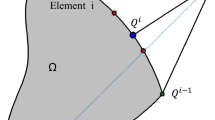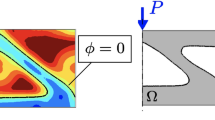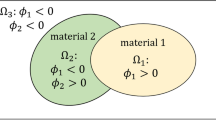Abstract
This paper studies level set topology optimization of structures predicting the structural response by the eXtended Finite Element Method (XFEM). In contrast to Ersatz material approaches, the XFEM represents the geometry in the mechanical model by crisp boundaries. The traditional XFEM approach augments the approximation of the state variable fields with a fixed set of enrichment functions. For complex material layouts with small geometric features, this strategy may result in interpolation errors and non-physical coupling between disconnected material domains. These defects can lead to numerical instabilities in the optimized material layout, similar to checker-board patterns found in density methods. In this paper, a generalized Heaviside enrichment strategy is presented that adapts the set of enrichment functions to the material layout and consistently interpolates the state variable fields, bypassing the limitations of the traditional approach. This XFEM formulation is embedded into a level set topology optimization framework and studied with “material-void” and “material-material” design problems, optimizing the compliance via a mathematical programming method. The numerical results suggest that the generalized formulation of the XFEM resolves numerical instabilities, but regularization techniques are still required to control the optimized geometry. It is observed that constraining the perimeter effectively eliminates the emergence of small geometric features. In contrast, smoothing the level set field does not provide a reliable geometry control but mainly improves the convergence rate of the optimization process.














Similar content being viewed by others
References
Allaire G, Jouve F, Toader AM (2004) Structural optimization using sensitivity analysis and a level-set method. J Comput Phys 194(1):363–393
Babuška I, Melenk JM (1997) The partition of unity method. Int J Numer Methods Eng 40(4):727–758
Bendsøe M (1989) Optimal shape design as a material distribution problem. Struct Multidiscip Optim 1(4):193–202
Bendsøe M, Kikuchi N (1988) Generating optimal topologies in structural design using a homogenization method. Comput Methods Appl Mech Eng 71(2):197–224
Bendsøe MP, Sigmund O (2003) Topology optimization: theory, methods and applications. Springer
Burger M, Osher SJ (2005) A survey in mathematics for industry a survey on level set methods for inverse problems and optimal design. Eur J Appl Math 16:263–301
de Ruiter M, van Keulen F (2000) Topology optimization: approaching the material distribution problem using a topological function description. In: Topping BHV (ed) Computational Techniques for Materials, Composites and Composite Structures, Edinburgh, pp 111–119
de Ruiter MJ, van Keulen F (2004) Topology optimization using a topology description function. Struct Multidiscip Optim 26(6):406–416
Daux C, Moes N, Dolbow J, Sukumark N, Belytschko T (2000) Arbitrary branched and intersecting cracks with the extended finite element method. Int J Numer Method Eng 48:1741–1760
Dolbow J, Harari I (2009) An efficient finite element method for embedded interface problems. Int J Numer Method Eng 78:229–252
Duysinx P, Miegroet L, Jacobs T, Fleury C (2006) Generalized shape optimization using x-fem and level set methods. In: IUTAM Symposium on Topological Design Optimization of Structures, Machines and Materials, Springer, pp 23–32
Fish J (1992) The s-version of the finite element method. Comput Struct 43(3):539–547
Fries T, Belytschko T (2010) The extended/generalized finite element method: an overview of the method and its applications. Int J Numer Methods Eng 84(3):253–304
Fries TP (2008) A corrected xfem approximation without problems in blending elements. Int J Numer Methods Eng 75(5):503–532
Fries TP (2009) The intrinsic xfem for two-fluid flows. Int J Numer Meth Fluids 60(4):437–471
Gerstenberger A, Wall WA (2008) An extended finite element method/Lagrange multiplier based approach for fluid-structure interaction. Comput Methods Appl Mech Eng 197:1699–1714
Guest J (2009) Topology optimization with multiple phase projection. Comput Methods Appl Mech Eng 199(1-4):123–135
Haber R, Bendsøe M (1998) Problem formulation, solution procedures and geometric modeling: key issues in variable-topology optimization. In: AIAA/USAF/NASA/ISSMO Symposium on Multidisciplinary Analysis and Optimization, AIAA, no. AIAA-1998-4948 in Collection of Technical Papers. Pt. 3
Hansbo A, Hansbo P (2004) A finite element method for the simulation of strong and weak discontinuities in solid mechanics. Comput Methods Appl Mech Eng 193(33–35):3523–3540
Juntunen M, Stenberg R (2009) Nitsche’s method for general boundary conditions. Math Comput 78:1353–1374
Kreissl S, Maute K (2011) Topology optimization for unsteady flow. Int J Numer Methods Eng 87:1229–1253
Kreissl S, Maute K (2012) Levelset based fluid topology optimization using the extended finite element method. Struct Multidiscip Optim 46(3):311–326
Lang C, Makhija D, Doostan A, Maute K (2013) A simple and efficient projection scheme for heaviside enriched xfem. Submitted to Computational Mechanics
Luo Z, Tong L, Wang MY, Wang S (2007) Shape and topology optimization of compliant mechanisms using a parameterization level set method. J Comput Phys 227(1):680–705
Maute K, Ramm E (1995) Adaptive topology optimization. Struct Multidiscip Optim 10(2):100–112
Maute K, Ramm E (1997) Adaptive topology optimization of shell structures. AIAA J 35(11):1767–1773
Maute K, Schwarz S, Ramm E (1998) Adaptive topology optimization of elastoplastic structures. Struct Multidiscip Optim 15(2):81–91
Maute K, Kreissl S, Makhija D, Yang R (2011) Topology optimization of heat conduction in nano-composites. In: 9th World Congress on Structural and Multidisciplinary Optimization, Shizuoka
Osher SJ, Sethian JA (1988) Fronts propagating with curvature dependent speed: algorithms based on Hamilton-Jacobi formulations. J Comput Phys 79:12–49
Pingen G, Waidmann M, Evgrafov A, Maute K (2010) A parametric level-set approach for topology optimization of flow domains. Struct Multidiscip Optim 41(1):117–131
Schleupen A, Maute K, Ramm E (2000) Adaptive fe-procedures in shape optimization. Struct Multidiscip Optim 19:282–302
Sethian J, Wiegmann A (2000) Structural boundary design via level set and immersed interface methods. J Comput Phys 163(2):489–528
Sigmund O (2009) Manufacturing tolerant topology optimization. Acta Mech Sinica/Lixue Xuebao 25(2):227–239
Sigmund O, Maute K (2012) Sensitivity filtering from a continuum mechanics perspective. Struct Multidiscip Optim:1–5
Sigmund O, Maute K (2013) Topology optimization approaches: a comparative review. Structural and Multidisciplinary Optimization Submitted
Sigmund O, Petersson J (1998) Numerical instabilities in topology optimization: a survey on procedures dealing with checkerboards, mesh-dependencies and local minima. Struct Multidiscip Optim 16(1):168–75
Stenberg R (1995) On some techniques for approximating boundary conditions in the finite element method. J Comput Appl Math 63(1–3):139–148
Svanberg K (2002) A class of globally convergent optimization methods based on conservative convex separable approximations. SIAM J Optim 12:555–573
Terada K, Asai M, Yamagishi M (2003) Finite cover method for linear and non-linear analyses of heterogeneous solids. Int J Numer Methods Eng 58(9):1321–1346. doi:10.1002/nme.820
van Dijk N, Langelaar M, van Keulen F (2012) Explicit level-set-based topology optimization using an exact heaviside function and consistent sensitivity analysis. Int J Numer Methods Eng 91(1):67–97
van Dijk N, Maute K, Langelaar M, Keulen F (2013) Level-set methods for structural topology optimization: a review. Struct Multidiscip Optim pp 1–36
van Miegroet L, Duysinx P (2007) Stress concentration minimization of 2d filets using x-fem and level set description. Struct Multidiscip Optim 33(4–5):425–438
van Miegroet L, Moës N, Fleury C, Duysinx P (2005) Generalized shape optimization based on the level set method. In: 6th World Congress of Structural and Multidisciplinary Optimization
Wang F, Lazarov BS, Sigmund O (2011) On projection methods, convergence and robust formulations in topology optimization. Struct Multidiscip Optim 43(6):767–784
Wang MY, Wang X, Guo D (2003) A level set method for structural topology optimization. Comput Methods Appl Mech Eng 192(1–2):227–246. doi:10.1016/S0045-7825(02)00559-5
Wang S, Wang MY (2006a) Radial basis functions and level set method for structural topology optimization. Int J Numer Methods Eng 65(12):2060–2090
Wang S, Wang MY (2006b) A moving superimposed finite element method for structural topology optimization. Int J Numer Meth Eng 65:1892–1922
Wei P, Wang M, Xing X (2010) A study on X-FEM in continuum structural optimization using a level set model. Comput-Aided Des 42(8):708–719
Wilke DN, Kok S, Groenwold AA (2006) A quadratically convergent unstructured remeshing strategy for shape optimization. Int J Numer Methods Eng 65(1):1–17
Xia Q, Shi T, Liu S, Wang MY (2012) A level set solution to the stress-based structural shape and topology optimization. Comput Struct 90–91:55–64
Yamada T, Izui K, Nishiwaki S, Takezawa A (2010) A topology optimization method based on the level set method incorporating a fictitious interface energy. Comput Methods Appl Mech Eng 199(45–48):2876–2891
Zhou M, Rozvany GIN (1991) The COC algorithm, part II: topological, geometrical and generalized shape optimization. Comput Methods Appl Mech Eng 89(1–3):309–336
Acknowledgments
The author acknowledges the support of the National Science Foundation under grants EFRI–SEED–1038305 and CMMI–1201207. The opinions and conclusions presented in this paper are those of the authors and do not necessarily reflect the views of the sponsoring organization.
Author information
Authors and Affiliations
Corresponding author
Rights and permissions
About this article
Cite this article
Makhija, D., Maute, K. Numerical instabilities in level set topology optimization with the extended finite element method. Struct Multidisc Optim 49, 185–197 (2014). https://doi.org/10.1007/s00158-013-0982-x
Received:
Revised:
Accepted:
Published:
Issue Date:
DOI: https://doi.org/10.1007/s00158-013-0982-x




